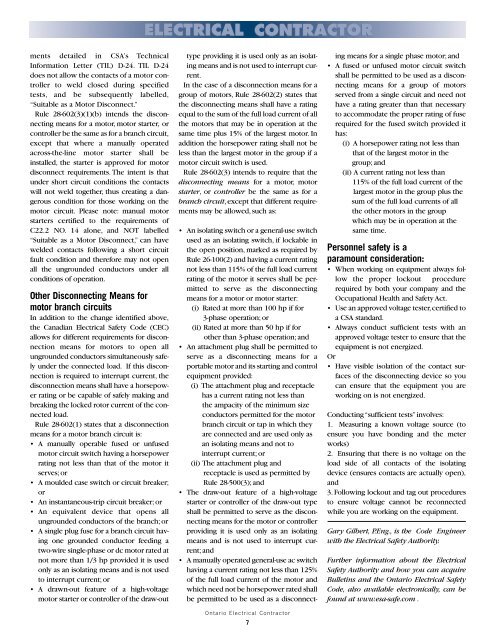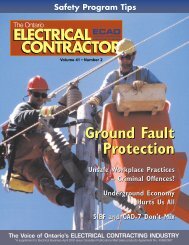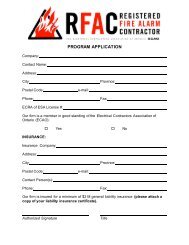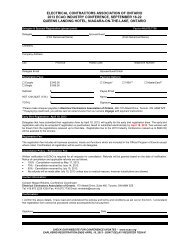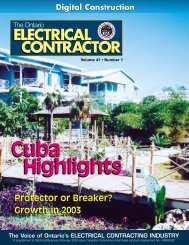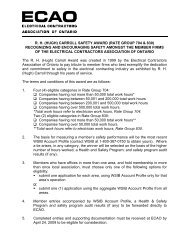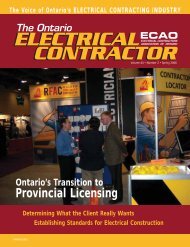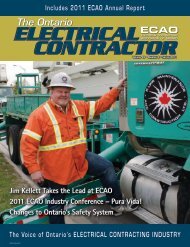contractor - Electrical Contractors Association of Ontario
contractor - Electrical Contractors Association of Ontario
contractor - Electrical Contractors Association of Ontario
Create successful ePaper yourself
Turn your PDF publications into a flip-book with our unique Google optimized e-Paper software.
ELECTRICAL CONTRACTORments detailed in CSA’s TechnicalInformation Letter (TIL) D-24. TIL D-24does not allow the contacts <strong>of</strong> a motor controllerto weld closed during specifiedtests, and be subsequently labelled,“Suitable as a Motor Disconnect.”Rule 28-602(3)(1)(b) intends the disconnectingmeans for a motor, motor starter, orcontroller be the same as for a branch circuit,except that where a manually operatedacross-the-line motor starter shall beinstalled, the starter is approved for motordisconnect requirements. The intent is thatunder short circuit conditions the contactswill not weld together, thus creating a dangerouscondition for those working on themotor circuit. Please note: manual motorstarters certified to the requirements <strong>of</strong>C22.2 NO. 14 alone, and NOT labelled“Suitable as a Motor Disconnect,” can havewelded contacts following a short circuitfault condition and therefore may not openall the ungrounded conductors under allconditions <strong>of</strong> operation.Other Disconnecting Means formotor branch circuitsIn addition to the change identified above,the Canadian <strong>Electrical</strong> Safety Code (CEC)allows for different requirements for disconnectionmeans for motors to open allungrounded conductors simultaneously safelyunder the connected load. If this disconnectionis required to interrupt current, thedisconnection means shall have a horsepowerrating or be capable <strong>of</strong> safely making andbreaking the locked rotor current <strong>of</strong> the connectedload.Rule 28-602(1) states that a disconnectionmeans for a motor branch circuit is:• A manually operable fused or unfusedmotor circuit switch having a horsepowerrating not less than that <strong>of</strong> the motor itserves; or• A moulded case switch or circuit breaker;or• An instantaneous-trip circuit breaker; or• An equivalent device that opens allungrounded conductors <strong>of</strong> the branch; or• A single plug fuse for a branch circuit havingone grounded conductor feeding atwo-wire single-phase or dc motor rated atnot more than 1/3 hp provided it is usedonly as an isolating means and is not usedto interrupt current; or• A drawn-out feature <strong>of</strong> a high-voltagemotor starter or controller <strong>of</strong> the draw-outtype providing it is used only as an isolatingmeans and is not used to interrupt current.In the case <strong>of</strong> a disconnection means for agroup <strong>of</strong> motors, Rule 28-602(2) states thatthe disconnecting means shall have a ratingequal to the sum <strong>of</strong> the full load current <strong>of</strong> allthe motors that may be in operation at thesame time plus 15% <strong>of</strong> the largest motor. Inaddition the horsepower rating shall not beless than the largest motor in the group if amotor circuit switch is used.Rule 28-602(3) intends to require that thedisconnecting means for a motor, motorstarter, or controller be the same as for abranch circuit, except that different requirementsmay be allowed, such as:<strong>Ontario</strong> <strong>Electrical</strong> Contractor7• An isolating switch or a general-use switchused as an isolating switch, if lockable inthe open position, marked as required byRule 26-100(2) and having a current ratingnot less than 115% <strong>of</strong> the full load currentrating <strong>of</strong> the motor it serves shall be permittedto serve as the disconnectingmeans for a motor or motor starter:(i) Rated at more than 100 hp if for3-phase operation; or(ii) Rated at more than 50 hp if forother than 3-phase operation; and• An attachment plug shall be permitted toserve as a disconnecting means for aportable motor and its starting and controlequipment provided:(i) The attachment plug and receptaclehas a current rating not less thanthe ampacity <strong>of</strong> the minimum sizeconductors permitted for the motorbranch circuit or tap in which theyare connected and are used only asan isolating means and not tointerrupt current; or(ii) The attachment plug andreceptacle is used as permitted byRule 28-500(3); and• The draw-out feature <strong>of</strong> a high-voltagestarter or controller <strong>of</strong> the draw-out typeshall be permitted to serve as the disconnectingmeans for the motor or controllerproviding it is used only as an isolatingmeans and is not used to interrupt current;and• A manually operated general-use ac switchhaving a current rating not less than 125%<strong>of</strong> the full load current <strong>of</strong> the motor andwhich need not be horsepower rated shallbe permitted to be used as a disconnectingmeans for a single phase motor; and• A fused or unfused motor circuit switchshall be permitted to be used as a disconnectingmeans for a group <strong>of</strong> motorsserved from a single circuit and need nothave a rating greater than that necessaryto accommodate the proper rating <strong>of</strong> fuserequired for the fused switch provided ithas:(i) A horsepower rating not less thanthat <strong>of</strong> the largest motor in thegroup; and(ii) A current rating not less than115% <strong>of</strong> the full load current <strong>of</strong> thelargest motor in the group plus thesum <strong>of</strong> the full load currents <strong>of</strong> allthe other motors in the groupwhich may be in operation at thesame time.Personnel safety is aparamount consideration:• When working on equipment always followthe proper lockout procedurerequired by both your company and theOccupational Health and Safety Act.• Use an approved voltage tester,certified toa CSA standard.• Always conduct sufficient tests with anapproved voltage tester to ensure that theequipment is not energized.Or• Have visible isolation <strong>of</strong> the contact surfaces<strong>of</strong> the disconnecting device so youcan ensure that the equipment you areworking on is not energized.Conducting “sufficient tests”involves:1. Measuring a known voltage source (toensure you have bonding and the meterworks)2. Ensuring that there is no voltage on theload side <strong>of</strong> all contacts <strong>of</strong> the isolatingdevice (ensures contacts are actually open),and3. Following lockout and tag out proceduresto ensure voltage cannot be reconnectedwhile you are working on the equipment.Gary Gilbert, P.Eng., is the Code Engineerwith the <strong>Electrical</strong> Safety Authority.Further information about the <strong>Electrical</strong>Safety Authority and how you can acquireBulletins and the <strong>Ontario</strong> <strong>Electrical</strong> SafetyCode, also available electronically, can befound at www.esa-safe.com .


